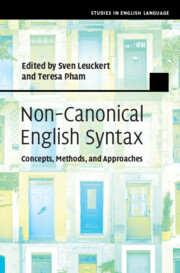Refine search
Actions for selected content:
6584 results in Grammar and Syntax
6 - The Grammatical Asymmetry Revisited
-
- Book:
- Linguistic Illusions
- Published online:
- 30 October 2025
- Print publication:
- 02 October 2025, pp 93-105
-
- Chapter
- Export citation
Preface
-
- Book:
- Linguistic Illusions
- Published online:
- 30 October 2025
- Print publication:
- 02 October 2025, pp xiii-xiv
-
- Chapter
- Export citation
Figures
-
- Book:
- Linguistic Illusions
- Published online:
- 30 October 2025
- Print publication:
- 02 October 2025, pp ix-x
-
- Chapter
- Export citation
4 - Leading Accounts of Attraction
-
- Book:
- Linguistic Illusions
- Published online:
- 30 October 2025
- Print publication:
- 02 October 2025, pp 62-76
-
- Chapter
- Export citation
Glossary
-
- Book:
- Linguistic Illusions
- Published online:
- 30 October 2025
- Print publication:
- 02 October 2025, pp 136-152
-
- Chapter
- Export citation
Contents
-
- Book:
- Linguistic Illusions
- Published online:
- 30 October 2025
- Print publication:
- 02 October 2025, pp vii-viii
-
- Chapter
- Export citation
1 - Introduction
-
- Book:
- Linguistic Illusions
- Published online:
- 30 October 2025
- Print publication:
- 02 October 2025, pp 1-12
-
- Chapter
- Export citation
Index
-
- Book:
- Linguistic Illusions
- Published online:
- 30 October 2025
- Print publication:
- 02 October 2025, pp 169-172
-
- Chapter
- Export citation
Copyright page
-
- Book:
- Linguistic Illusions
- Published online:
- 30 October 2025
- Print publication:
- 02 October 2025, pp iv-iv
-
- Chapter
- Export citation
References
-
- Book:
- Linguistic Illusions
- Published online:
- 30 October 2025
- Print publication:
- 02 October 2025, pp 153-168
-
- Chapter
- Export citation
5 - Theory Arbitration
-
- Book:
- Linguistic Illusions
- Published online:
- 30 October 2025
- Print publication:
- 02 October 2025, pp 77-92
-
- Chapter
- Export citation

Non-Canonical English Syntax
- Concepts, Methods, and Approaches
- Coming soon
-
- Expected online publication date:
- September 2025
- Print publication:
- 28 August 2025
-
- Book
- Export citation
9 - The Origins of Hierarchy: Bare Phrase Structure
- from Part I - Configuration and Hierarchy
-
- Book:
- Continuing Syntax
- Published online:
- 03 October 2025
- Print publication:
- 25 September 2025, pp 176-194
-
- Chapter
- Export citation
12 - Phases and Phase Impenetrability
- from Part II - Locality
-
- Book:
- Continuing Syntax
- Published online:
- 03 October 2025
- Print publication:
- 25 September 2025, pp 238-256
-
- Chapter
- Export citation
11 - Covert Movement, Copy Theory and Reconstruction
- from Part II - Locality
-
- Book:
- Continuing Syntax
- Published online:
- 03 October 2025
- Print publication:
- 25 September 2025, pp 219-237
-
- Chapter
- Export citation
Part I - Configuration and Hierarchy
-
- Book:
- Continuing Syntax
- Published online:
- 03 October 2025
- Print publication:
- 25 September 2025, pp 1-194
-
- Chapter
- Export citation
4 - Hierarchy and Categories I: Refining the Structure of the Clause and the VP
- from Part I - Configuration and Hierarchy
-
- Book:
- Continuing Syntax
- Published online:
- 03 October 2025
- Print publication:
- 25 September 2025, pp 76-96
-
- Chapter
- Export citation
3 - Hierarchy II: C-Command, Head-Movement and Locality
- from Part I - Configuration and Hierarchy
-
- Book:
- Continuing Syntax
- Published online:
- 03 October 2025
- Print publication:
- 25 September 2025, pp 55-75
-
- Chapter
- Export citation
14 - The Syntax of Silence I: Ellipsis
- from Part II - Locality
-
- Book:
- Continuing Syntax
- Published online:
- 03 October 2025
- Print publication:
- 25 September 2025, pp 272-289
-
- Chapter
- Export citation
2 - Hierarchy I: Phrase Structure and Grammatical Functions
- from Part I - Configuration and Hierarchy
-
- Book:
- Continuing Syntax
- Published online:
- 03 October 2025
- Print publication:
- 25 September 2025, pp 29-54
-
- Chapter
- Export citation
